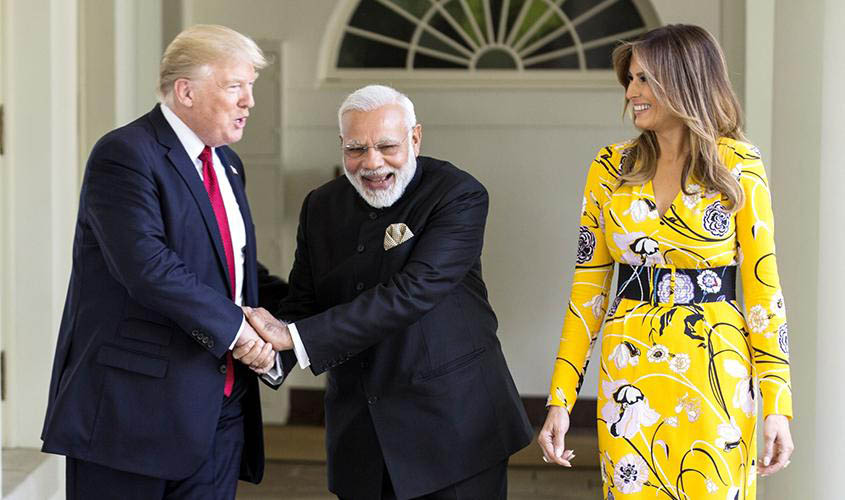 Present day India-US relations have to be monitored objectively—without the overhang of the past regimes in the two countries—to evaluate the degree of geo-political convergence that exists between the two largest democracies. Prime Minister Narendra Modi received a red carpet treatment in President Donald Trump’s Washington. In the period that has followed, the two countries have moved towards a meaningful sharing of interests in the spheres of both economy and security. This is rooted in three important parameters of national policy on both sides—a firm opposition to terrorist violence by Islamic extremists, friendship for mutual economic benefits, and a shared view on the emerging global scenario.
Present day India-US relations have to be monitored objectively—without the overhang of the past regimes in the two countries—to evaluate the degree of geo-political convergence that exists between the two largest democracies. Prime Minister Narendra Modi received a red carpet treatment in President Donald Trump’s Washington. In the period that has followed, the two countries have moved towards a meaningful sharing of interests in the spheres of both economy and security. This is rooted in three important parameters of national policy on both sides—a firm opposition to terrorist violence by Islamic extremists, friendship for mutual economic benefits, and a shared view on the emerging global scenario.
During his election campaign, Donald Trump had come out bold and clear against the threat from Islamic radicals and had squarely denounced Hillary Clinton for trying to be “politically correct” in refusing to admit that terror was being unleashed in the name of Islam. Trump’s first foreign visit was to Saudi Arabia, where he made no bones about the need to combat Islamic extremism. He declared that the United States’ role was aimed at rooting out terrorism. He told a gathering of 50 Arab and Muslim leaders to come out of the “confines of rigid thinking” and decide what kind of future they wanted for their children.
Coming back to the highlight of the Indian PM’s visit to Washington, it may be recalled that the Trump-Modi joint statement declared their resolve to cooperate fully in the spheres of both economy and security, sealing the friendship between the two leaders and putting India on the global map as a close strategic partner of the US. The two leaders demonstrated their ability to define their “shared vision”, without getting bogged down by solvable differences pertaining to variables like trade and visa. The joint statement expressly mentioned cross border terrorism, calling upon Pakistan to stop it and asked that country to bring 26/11 and Pathankot culprits to justice. By listing Syed Salahuddin—who colluded with Hafiz Saeed of Lashkar-e-Taiba and guided the militant fronts of Jamaat-e-Islami Kashmir—as a “specially designated global terrorist”, the US for the first time dropped the practice of making a distinction between “good terrorists” and “bad terrorists” when dealing with Pakistan.
Again, the base for an enlarged India-US strategic partnership to cover the global scene was laid during PM’s visit to Washington. In regard to the Indo-Pacific region, the Trump-Modi joint statement described US and India as “responsible stewards”, whose partnership was central to peace and stability there, and demanded freedom of navigation, overflight and commerce throughout the region. India’s stand on China’s Belt and Road Initiative (BRI), with particular reference to China Pakistan Economic Corridor (CPEC) was fully endorsed by the joint statement, which stated that regional economic connectivity had to respect sovereignty and territorial integrity of other states. With the visible emergence of the Sino-Pak axis as a military alliance, the consolidation of US-Israel-Japan-India strategic unity has proceeded well, as the recent joint exercises by the naval ships of India, US, and Japan demonstrated. Today, “war pacts” are not needed and India does not have to carry the ideological baggage of non-alignment while working for its national security.
Donald Trump’s policy statement on Afghanistan made earlier this week reflects the US President’s characteristic determination to eliminate the scourge of Islamic terror spread by radicals in the two battle centres in the territories of Afghanistan and Iraq-Syria. There is little doubt that the Barack Obama administration’s tentative approach towards Afghanistan after the elimination of Osama bin Laden and the ambiguity of Pakistani military establishment towards Islamic radicals facilitated the consolidation of like-minded groups such as Al Qaeda, Taliban and ISIS in Afghanistan. Trump had got going on his campaign promise of eradicating Islamic radicals by dropping the biggest non-nuclear bomb—the 10,000 kg MOAB—on the ISIS stronghold in Afghanistan’s Tangadhar area on the Pak-Afghan border.
Trump has now clarified that more US troops will be brought to Afghanistan to gain a “decisive victory” and authorised Pentagon to take decisions on the ground. He has minced no words in directing Pakistan to put its act together in combating Islamic radicals. Significantly, he has recognised a major role for India in the economic development of Afghanistan. On the whole, India and US are on the same page on the important matter of South Asia’s security. India’s security and diplomatic establishments will no doubt be taking this forward in the country’s best interests.
President Trump’s stand on Pakistan and Afghanistan helps India to pursue its policy of putting down terrorists in Kashmir and to deal with the pro-Pak separatists, firmly. The democratic government of Jammu and Kashmir has, at the same time, the freedom to reach out to its people, step up development and revive the spirit of Kashmiriyat, which brought both Muslims and Hindus to the shrines of saints and pirs and shunned extremism. It should use the state intelligence to identify Pakistan’s agents embedded in the state administration, for suitable action. Finally, the coalition government needs to clarify to the state’s political parties that the matter of dealing with Pakistan on the Kashmir issue is entirely in the domain of the Centre.
D.C. Pathak is a former Director, Intelligence Bureau

